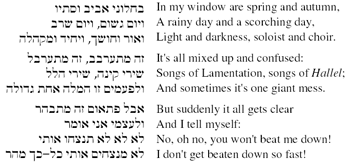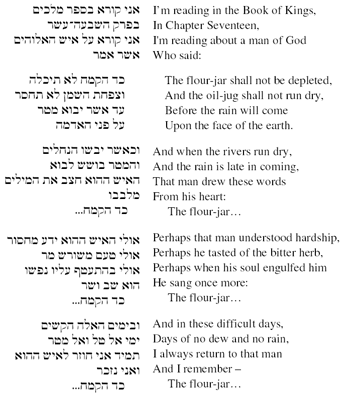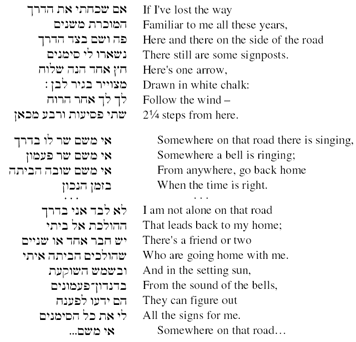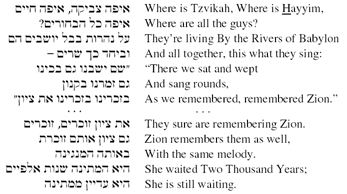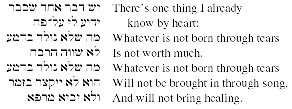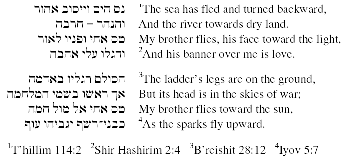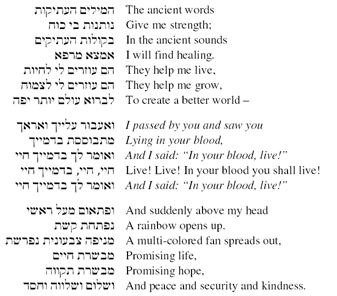Haderekh Arukah: The Songs of Naomi Shemer
by Cantor Sam Weiss
This article first appeared in Volume 32, Fall 2007 of The Journal of Synagogue Music, published by The Cantors Assembly.
Since the legendary songwriter's death, I renewed my acquaintance with the Naomi Shemer songs that have traversed the years and the oceans to become international hits. I also made my acquaintance with a musical treasure trove that was new to me—numerous songs long-celebrated in Israel, but not well-known abroad. These discoveries and rediscoveries have been rewarding and reassuring. The feeling of reassurance comes from the realization that Shemer's expanse of spirit and humanity has had a broad audience in a nation with such a harsh history and (probably) a harsh future. For if there is comfort in witnessing Israelis survive and persevere, there is even greater solace in knowing that the best parts of their humanity can and will endure as well.
For close to five decades the appeal of Naomi Shemer's works has stayed strong due to the craft and clarity of her lyrics and to the charm of her melodies. Her audience has been much wider than most singers' because of her long career as a songwriter for musicals, recordings, films and television programs. A great variety of artists and performing groups have disseminated her sensitivity and understanding, enabling her sentiments to pervade Israeli society even more readily than those of a fine novelist or poet laureate whose works—like Shemer's—are part of the national school curriculum. The immediacy of her words and music has even forged a bond between the sensibilities of Israeli citizens and of Diaspora Jews—and that is doubly reassuring.
As for the rewards that I have found in her works, that is the subject of the rest of this article. In listening to over a hundred compositions and perusing many more, I was fully prepared to characterize the "typical" Naomi Shemer song. How delightful is the impossibility of such an assignment! Each melody rises anew, bringing a fresh imaginative poem to life. At the same time, one is touched by a unifying spirit that seems to hover over her entire oeuvre. It is a spirit of gentle, pensive optimism, a quasi-religious optimism that takes the long view, embracing the bitter along with the sweet (Al Kol Eileh) and singing Halleluyah on a never-ending holiday that celebrates everything from an infant's first steps to a baker's fresh bread (Yeish Li Khag). It is a feeling of hope that the composer has transposed to her songs from the zemirot sung by her father (Shiro Shel Aba) and from her mother's prayerful pose in the portrait she keeps on her piano (Dyokan Imi).
Not too often, however, does Shemer offer us optimism—or any other mood or feeling—in its simple unalloyed form. There is frequently a shade of doubt, a tinge of sadness, or some other contrasting emotion vying for our heart's attention. For example, with a title and a refrain like "You Won't Beat Me Down" (Lo T'natz'khu Oti) we might expect a song of utter triumph. Instead, we hear these final verses1
When there is little incentive to sing, she admits as much but continues to sing nonetheless, as in Khevlei Mashi'akh:
Sometimes all that one can do when bad news predominates is to turn lemon into lemonade, as in the wry song Ein Li Rega Dal (Never A Dull Moment).
Optimism is the reigning spirit even for the dejected characters in Shemer's songs, and they are rarely left in total despondence. The beautiful lament Al Tish'alu Oti (Don't Ask Me) is a catalogue of woes, a tale of songs silenced by a guitar that has been shattered against the rocks. But in the final verse our erstwhile singer concludes: "Only silence flows, like a river; / From the stones on the shore an echo calls. / Perhaps tomorrow I will sing a new song." Even the guitar, speaking for itself, says quite plainly in Ani Gitarah:
Optimism is one thing, but unbridled jubilation is quite another—and the latter is not at all common in Shemer's works. It is interesting to observe how Israel's history and the passing of time temper the artist herself. In 1963 she pens the exuberantly confident Makhar (Tomorrow), with its golden apples, pealing bells, and the proverbial lion lying with the lamb. We only partly believe her when she adds kol zeh eino mashal v'lo khalom ("all of this is not a fable or a dream"). By 1976, with the passing of many a mokhrotayim of travail, she offers a less sanguine vision of what we might expect from our tomorrows; in Hakhagigah Nigmeret (The Party's Over) she writes:
Finally, by 1994 she adopts a more balanced view of the future with this refrain of Hakol Patu'akh—
More characteristically, such an ebb and flow of emotions will occur within a single song, as in Lashir Zeh K'mo Lihyot Yardein (To Sing Is Like Being The Jordan). The striking title conjures up the positive feelings of flowing energy that might be felt by a singer, and that is exactly what we read in the first verse. But by the third and final verse we understand the poet's true intention, as she follows the metaphor to its grim logical conclusion:
Shemer's penchant for emotional complexity is epitomized in Ein Davar, whose refrain is the paradoxical statement by Rabbi Menachem Mendel of Kotzk, "There is nothing more complete than a broken heart, and no louder scream than silence." Shemer mines the poetic potential in this idea, and then sets her lyrics of bittersweet melancholy to a melody that moves ambivalently between major and minor cadences (Example 1—click on image to enlarge).
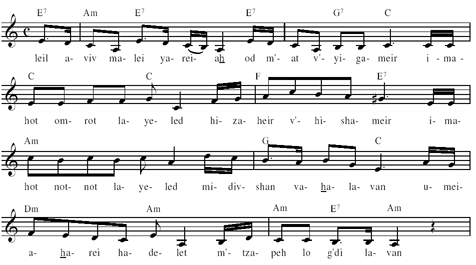
Example 1: A moonlit evening in spring; before long, it will end. Mothers warn the child—"Be careful, watch yourself!" Mothers give the child their honey and their milk; and on the other side of the door a white baby-goat awaits him …
She reserves her final musical judgment on this enigma for the refrain, whose upbeat melody transforms Der Kotzker's conundrum into a statement of purpose (Example 2—click on image to enlarge):
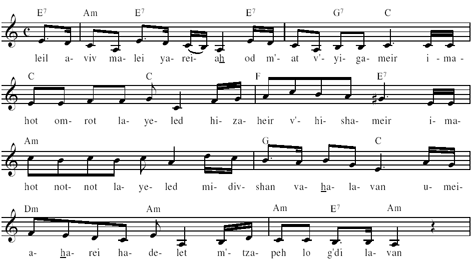
Example 2: There is nothing more complete than a broken heart, and no louder scream than silence.
Shemer wrote many poems that were never set to music; she set to music poems of other writers; and she translated a number of foreign songs into Hebrew—but it would be very wrong to think of her simply as a poet who was also a composer: She was a true songwriter, creating wonderful lyrics, and tunes that wrap smoothly around the words. As we saw in Ein Davar, a songwriter's message is oftentimes not completely contained in the lyrics. This is certainly true of many of her songs, in which the whole is frequently different from—and often greater than—the sum of its two parts. To take a well-known song as an example: If you recite slowly the lyrics of Od Lo Ahavti Dai ("Still Haven't Loved Enough") without hearing the familiar snappy melody in your ears, you will find that this unrelenting series of short negative sentences could just as well have turned into a rather doleful ballad. The joyful melody is the "Rashi" that yields the true interpretation of the songwriter's words. I tried this exercise of words vs. words-and-music on a number of unfamiliar Shemer songs that I learned from the printed page, and have acquired a new admiration for her musical magic.
* * * * * *
Naomi Shemer's first hit song, Zamar Nodeid (The Wandering Minstrel), was written in 1958, a time of transition in Israeli popular music. People were still singing the old folksongs as well as newer songs about the desert blooming into nationhood; and they still sang about the wartime victories and losses of 1948 and 1956. At the same time, theatrical entertainments were producing songs about the ups and downs of life in the new state, and descriptive lyrics about various and sundry other situations. In this milieu, Shemer's song in the first person singular was quite novel. It expressed a cheerful universal feeling without a hint of the Israeli context in which it was composed:
Shemer's compositions were a breath of fresh air melodically as well. Even her earliest tunes have a "pop music" sensibility and generally do not sound like the waltzes, tangos and other European styles that served as popular music models in the late 1950s. Nor do they sound like the classic Israeli folksongs—with their sequential melodies in minor keys and their syncopated Hora rhythms—or their musical offshoots favored in those years by singers like Shoshana Damari and Yaffa Yarkoni. Here, for instance are sections from two Naomi Shemer songs written in 1958, an atmospheric one about Tel-Aviv, "The White Town" (Ha'ir Hal'vanah) (Example 3—click on image to enlarge), and one about coy and undecided No'a (Example 4—click on image to enlarge). Both are interesting melodies that draw their interest from—and the listener's attention to—equally engaging lyrics.

Example 3: Out of foam, wave and cloud I built myself a white city—just as frothy, flowing and beautiful.
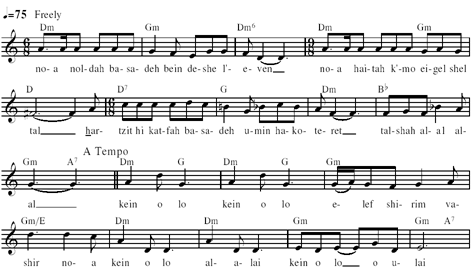
Example 4: Noa was born in a field between grass and stone; she was like a drop of dew. She picked a daisy in the field and plucked one petal at a time: Yes or no, yes or no—a thousand and one songs, Noa—Yes or no, oh my petals—Yes or no, or maybe.
There are occasional exceptions to Shemer's forward-looking compositional approach. For Kibui Orot (Lights Out), a 1958 song about a military encampment in the desert at nightfall, she writes a melody reminiscent of the old "camel caravan" songs (Example 5—click on image to enlarge).

Example 5: Night has come to the desert; smoke rises from the campfires and the sound of drums is fading. The red-faced moon is budding over the prairies.
When setting the works of other poets, Shemer will sometimes favor the older melodic structures, as in Rakhel's poem Zemer (Example 6—click on image to enlarge).

Example 6: Morning and evening to you and about you my poems sang. Storm and calm, joy and tears; hurting and healing, pleasure and pain.
Shaul Tchernichovsky's Hoi Artzi Molad'ti (O, My Homeland), which looks back to the days of yore, is fitted with a suitably old-fashioned tonality (Example 7—click on image to enlarge).

Example 7: Monasteries, a mound, a gravestone; clay dome on a house, a settlement not settled; olive trees in a row.
However, the same poet's timeless Omrim Yeshnah Eretz (They Tell Of A Land) is given an entirely different musical treatment, with a particularly majestic second strain (Example 8—click on image to enlarge).

Example 8: A land where every man's hope will come to pass. Enter all who will. One man was met by Rabbi Akiva.
As to the other side of the songwriter's craft, Shemer's words are truly meant to be sung. They generally add up to only a few verses, with rhyming lines that scan well metrically. In addition, the poems often have a narrative, conversational, or other dynamic quality that propels them into our consciousness and onto our lips. Her biblical allegory Kad Hakemakh (The Flour-Jar) is a wonderful example in this regard. It begins in the first person; it proceeds to tell a story in the third person; it cites the words of God to Elijah as its refrain; the last line of every verse leads directly into this quote (each time with a different verb); and at the end, the biblical episode is brought to bear on contemporary Israeli concerns. Remarkably, this feat is accomplished in only four brief verses:
Shemer's lyrics make use of other structural elements as singing "hooks." Often the opening verse is echoed, reformulated, or restated in the final verse. Another technique she uses is the "dual refrain"—that is, a recurring phrase that weaves through the verses and also forms part of the refrain proper. The words lu y'hi function this way in the famous song by that title. Every third line of the song is kol shen'vakeish lu y'hi, including the refrain, which is
A similar example is Al Kol Eileh (For All Of These), a song that repeats a number of words and phrases throughout, albeit in an asymmetrical pattern. Such devices can turn a great song into a hit—witness the continued popularity of both Lu Y'hi and Al Kol Eileh.
* * * * * *
Zamar Nodeid not only paved the way for greater creativity in Israeli popular lyrics, but also furnished its composer with a metaphor that would be a leitmotiv in her works to come: haderekh arukah—"the long road." It not only finds full expression as the theme of many songs, it also occurs as words and phrases within a large number of other songs. These combine to make "the long road" a literary trope that permeates the complete cycle of Naomi Shemer's songs. Songs that embody this theme explicitly include the many "road songs" like Hatiyul Hagadol (The Long Hike) and Khayalim Yatz'u Laderekh (Soldiers Enroute) as well as songs of flying through the air—Al Kanfei Hakesef (On Silvery Wings), Banayikh Meirakhok (Your Sons From Afar). There are also songs of journeying towards the beloved—El Borot Hamayim (To The Water Wells), of awaiting the beloved's return—Hakhayal Sheli Khazar (My Soldier Is Back) and of leaving and returning—Anakhnu Mei'oto Hak'far (We're From The Same Village). The starting points or destinations of the journeys are not always made clear, as in Shemer's parable Ha'orei'akh (The Guest) (Example 12), nor are the journeys easily accomplished, as in this song:
It is noteworthy that the only translation from Yiddish that Shemer published was her version of Itzik Manger's song Oyfn Veg Shteyt A Boym (Near The Road There Is A Tree). Perhaps she was drawn to this piece while setting to music Natan Alterman's poem Al Eim Haderekh (At The Crossroads), which shares with Manger's work a common source in the similarly titled Oyfn Veg Shteyt A Boym, a short Yiddish folksong about traveling to Zion. But the symbol of the road can hardly be coincidental, and must certainly have figured in her choice.
The marching, traveling, or journeying metaphor also appears in a wide variety of songs that are not explicitly based on the derekh arukah theme, yet contain this idea in a supporting role. Following are but a few examples: Al Kol Eileh has its "man returning home from a great distance," while in Lu Y'hi it is "the end of summer, the end of the road, / Allow them to return back here." At the beginning of Od Lo Ahavti Dai, these opening words seem to encapsulate the point of all the variegated imagery in the rest of the song: "I have not yet determined where the road will lead me, or where I'm headed." Makhar, that rousing anthem to optimism, derives its vigor not from the "thousand pealing bells" but from its opening "fantastic voyage"—
In Anashim Tovim, one of the songs that she recorded, Shemer sings about how we are constantly benefiting from so many "Good People" all around us. And guess where these good souls are to be found….
In Dyokan Imi we are made to see the portrait of Shemer's mother, and how it inspires the poet's journey through life:
The great span and indeterminate nature of Naomi Shemer's derekh arukah can easily turn it into a metaphor for the chronicles of Medinat Yisrael—which may help explain the compelling and epic quality of some of her imagery. This connection was movingly expressed in 1995, when Shemer translated and set to music Walt Whitman's poem "O Captain, My Captain" (written upon the assassination of Abraham Lincoln) in homage to the slain Yitzhak Rabin. Upon hearing Ho Rav Khoveil one feels that the composer is writing as a fellow voyager on Israel's Ship of State, and the effect is powerful.
If there is one song that sums up all of the literal and figurative voyages and journeys symbolized in Shemer's work, it would have to be Simanei Haderekh (Signs Along The Road)—
Naomi Shemer's output was quite wide-ranging; it includes children songs, novelty songs, songs about puppy love and romantic love—along with the many subjects we have already discussed. Yet despite the wide range and approachable quality of her lyrics—and despite the universality presaged in Zamar Nodeid—she is not a "universal" poet or composer. She is a palpably Israeli songwriter, closely tied to Israel's history and daily life, incorporating Israeli names, places, objects and themes throughout her work, and writing melodies that helped define the very genre of Israeli music.
She was in touch with enduring Jewish themes no less than with contemporary national concerns, writing Jewish holiday songs for children (Pesakh Kan, Neir Rishon Shel Khanukkah), sardonic commentaries and takeoffs on Jewish holiday songs (G'di Ekhad, Mi Yadlik) as well as many songs that quote extensively from Tanakh. Some of the latter have clearly delineated biblical themes, such as Kad Hakemakh, cited above. Often such a piece will have an ironic or even confrontational stance. Al Naharot Bavel is a biting critique of Israel's Yordim who prefer to sing about Israel while living by the Rivers of Babylon. Her concluding lines are trenchant indeed:
Akeidat Yitzkhak begins with a paraphrase of Genesis 22:2-3, describing the binding of Isaac, and ends with a challenging tone reminiscent of Levi-Yitzkhak of Berditchev's peremptory songs addressed to the Almighty:
But regardless of its theme, many a Naomi Shemer song is laced through with biblical vocabulary and metaphor. For example, within the brooding song Mah Sh'lomeikh Akhot (What's New, Sister?) we find an arresting poetic homily on the verse from Psalm 126, Hazor'im b'dim'ah b'rinah yiktzoru ("May those who sowed in tears reap in joy")—
In eight lines from Al Kanfei Hakesef, a song about the I.D.F. Air Force pilots, we find no fewer than four biblical allusions:
Moving beyond the Bible, we have a song like Arba'ah Akhim, which deconstructs à la Itzik Manger the Passover narrative of the Four Sons. Shivkhei Ma'oz takes similar liberties with the refrain of the Hanukkah hymn Ma'oz Tzur. The words of the iconic Yerushalayim Shel Zahav may not appear to have any specifically Jewish antecedents, until we realize that a "Jerusalem of Gold" was an ancient Jewish ornamental headdress that is mentioned in the Talmud (N'darim 50a) and other early sources.
Of course, it is extremely hard to tease apart the "Jewish" from the "Israeli" in an artist like Shemer, for whom the Bible and ancillary texts need not be religiously significant, but simply part of her nation's literary patrimony. Nevertheless, perhaps we may take her words at face value when she brings the words of Ezekiel (16:6) to bear on those who have sacrificed life and limb in Israel's tragedies, writing in one of her last songs—
The question of Naomi Shemer as a Jewish melodist is of interest no less than the question of Shemer as a Jewish poet. The examples that one can adduce are not many, but are significant nonetheless. The biblical song Akeidat Yitzkhak that we discussed above is set to a melody that echoes various cantillation and prayer modes. For the stage production of Mendele Moykher-Sforim's The Travels of Benjamin the Third, Shemer wrote Shirat Ha'asavim (Song Of The Grasses), based on the words of Rabbi Nakhman of Bratslav (Example 9—click on image to enlarge). Her T'hillim mode melody is pure T'fillah; and Shemer's own recording of the song has all the hallmarks of an affecting Ba'alat T'fillah.
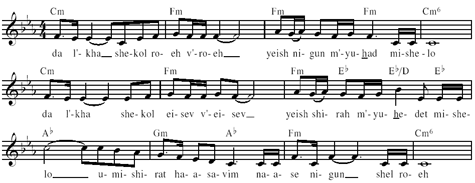
Example 9: Be aware that every single shepherd has his own individual song. Be aware that every blade of grass has its own individual melody, And from the song of the grasses comes the shepherd's melody.
There are several songs in which the composer highlights the narrative quality and textual rhythms of a passage by means of a recitative-like melody. Such passages cannot avoid associations with the chant of Davenen (Example 10—click on image to enlarge).

Example 10: When the Nakhal captured Sinai, so many beautiful things did my eye see! For instance….
Sometimes the "T'fillah effect" is a subtle one, but it is always a valid poetic gesture, as in Mah Sh'lomeikh Akhot, a rather dark song that lets in a fleeting moment of light by way of its refrain "You have me; I have you; we have each other." The music seems to halt for this moment of respite, and the words are chanted rather than sung (Example 11—click on image to enlarge).

Example 11: You have me; I have you; we have each other.
Similarly, there is a didactic quality to Shemer's parable Ha'orei'akh (The Guest) that is reinforced by its urgent yet flowing chant (Example 12—click on image to enlarge).

Example 12: If at the gate stands a guest who landed from overseas—What shall we serve that guest when he arrives from there?
* * * * * *
In trying to assess the "Jewish" nature of Naomi Shemer's metaphorical songs, I am essentially searching for a metaphor of my own—something on which to pin the faint aura of sanctity that suffuses so many of her finest songs. Be it a secular sanctity or a religious one, it is one worth treasuring. This kol d'mamah dakah—a soft sacred overtone—sings most persuasively to me in B'khol Shanah Bastav Giora (Every Year In Autumn, Giora), a song that is not typical of her works, but which best captures the supernal aspect of Shemer's poetry and music. Her compositional skills are quite evident in this elegy in blank verse to a young victim of the Yom Kippur War, Giora Shoham. The melody almost takes on the character of an art song, waxing and waning like an aching heart, sounding unmistakably like a tender prayer—not so much in her invocation of Psalm 121, as in the plaintive repetition of the words b'khol shanah bastav (Example 13—click on image to enlarge).
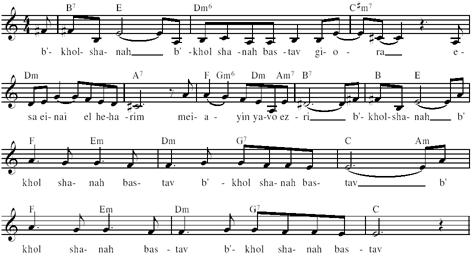
Example 13: [Every year in autumn, Giora, the wild wind in my garden nips off the very best roses.] Every year. Every year in autumn, Giora, I will lift up my eyes to the hills, from whence cometh my help. Every year in autumn.
The song continues in a passage laden with religious feeling, adding the names of comrades in the davenen manner of a khazzan chanting an Eil Malei Rakhamim. This passage cadences on the word n'dirim, eerily recalling the familiar Memorial Prayer cadence on the word maz'hirim (Example 14—click on image to enlarge).
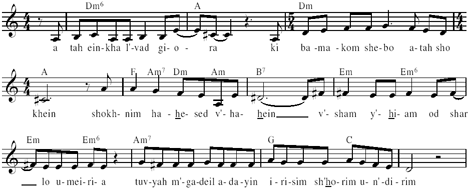
Example 14: You are not by yourself, Giora, because in the place in which you are residing reside lovingkindness and grace. And there Yehiam still sings and cheers; Tuviah still grows rare black irises.
Shemer reveals her intimate relationship with the biblical text in this poignant turn: "And there you are, and there the many young men are, about whom I would say that my help cometh from them." (Example 15—click on image to enlarge).

Example 15: And there you are, and there the many young men are, about whom I would say that my help cometh from them.
Finally, the poet skillfully modulates the mournful mood in a very personal reflection: "In the autumn of every year I ask my soul, 'When will I arrive there, to rest with you?' And the pain in my heart lifts." (Example 16—click on image to enlarge).

Example 16: In the autumn of every year I ask my soul, "When will I arrive there, to rest with you?" And the pain in my heart lifts.
On June 26, 2004 Naomi Shemer's soul did finally come to rest.
Y'hi zikhrah barukh.
1 All translations from the Hebrew are by the author. For technical reasons, the Hebrew letters "Khet" and "Khaf" in the original transliterations appear here as "kh". [return to article]
